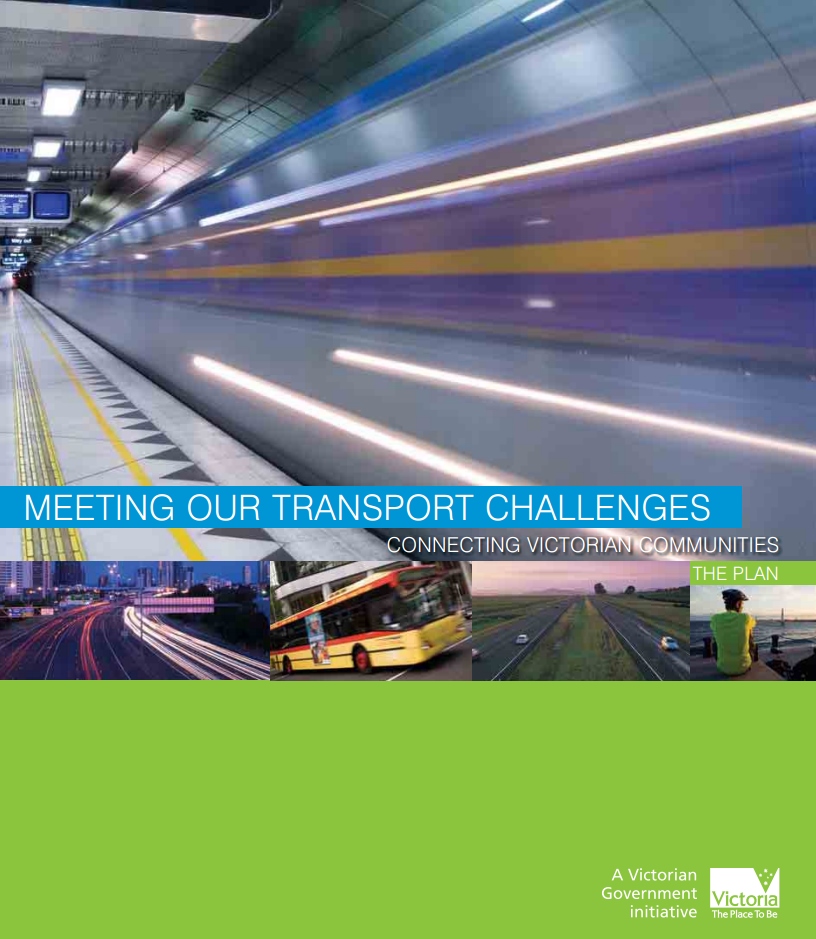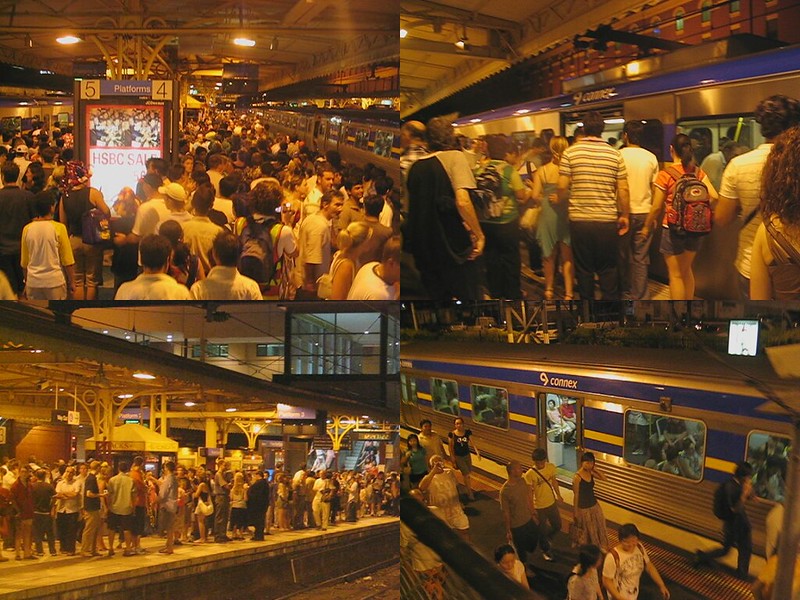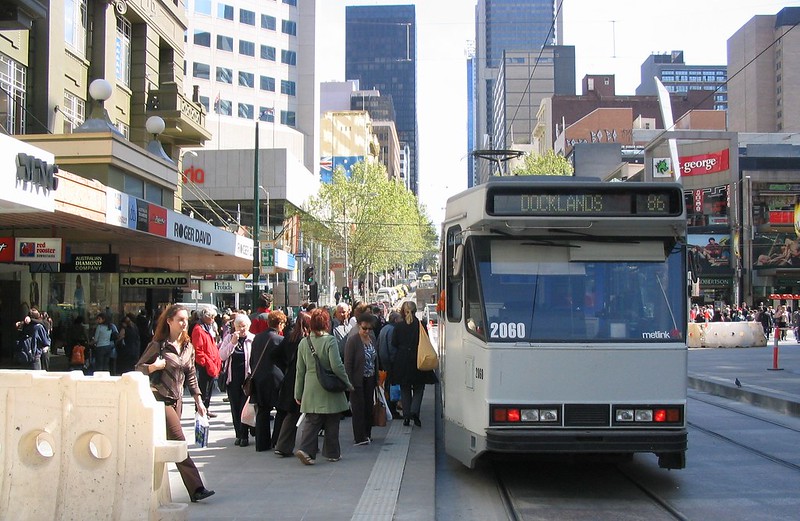Ten years ago today, the Bracks Government’s “Meeting Our Transport Challenges” plan was released. MOTC for short.
It wasn’t the first of the 1999-2010 Labor Government’s transport documents, nor would it be the last. It came following a stinging assessment of Melbourne’s public transport a few months earlier by Professor Peter Newman for the Metropolitan Transport Forum, and a sustained push for some kind of government strategy to provide some genuine solutions to car dependence.
The MOTC launch itself was perhaps symptomatic of the plan. The Premier Steve Bracks, Treasurer John Brumby and Minister Peter Batchelor all arrived by train in Frankston for the event — but they had only hopped on two stops before at Seaford. (It was a similar story a year later when the Craigieburn electrification opened.) The rest of their journey was by government car.
But it was the content of the plan that didn’t get people as excited as the government had perhaps hoped.
Following the launch, the PTUA called for Batchelor to resign. OK, I was the one that said the words for the cameras, but like all PTUA views, this was based on an agreed committee position: if by a fair assessment we judged that MOTC failed to provide substantial relief from car dependence, it was to be declared a flop.
Towards the end of the year, Batchelor, who had presided over the conception of the Myki project and the scrapping of trains (only to be bought back later when patronage surged), was replaced by Lynne Kosky in a reshuffle following the 2006 state election. (Only after that did the government start inviting PTUA to events again!)
So what was in the MOTC plan itself? Here I’ve gone through the Actions from the summary section of the document:
DELIVERING FOR THE FUTURE — The MOTC Reserve fund of $5.9 billion over ten years, to ensure transport funding was available into the future. At the time, Batchelor described it a bit like Abbott’s “locked box”. Perhaps this is still down as a line item in some obscure part of the budget, but as far as the public goes, it has disappeared.
CREATING A CROSS-TOWN TRANSPORT NETWORK FOR MELBOURNE — the Smartbus crosstown orbital network. Three of the proposed routes were delivered, now the 901, 902 and 903. The fourth was to have been the 904 (hence the gap in route numbers), but never happened. This would have run from Sandringham via Elsternwick, Punt Road, Clifton Hill, then across to Brunswick, Footscray and Williamstown, amalgamating routes 246, 472 and others, providing frequent inner-city connections to make cross-town trips faster and take pressure off CBD services. See the map here. PTUA and PTNT are still pushing for this route as part of a package of better bus services.
BOOSTING MELBOURNE’S RAIL NETWORK — capacity upgrades on the City Loop, Dandenong, Clifton Hill and Northern Group, and stations at Point Cook, Cardinia Road, and Lynbrook. The stations got done. Various works have occurred on most of the lines mentioned, such as duplication from Clifton Hill to Westgarth, and duplication of the Epping line north of Keon Park, all done as part of the South Morang line extension.
The Dandenong line proposal was a third track — a plan now dumped (and not just because four tracks are better than three) in favour of grade separation, longer trains and better signalling.
But the plan also included relatively minor upgrades which haven’t happened, such as an extra platform at Sandringham. At least the new stations have been built.
IMPROVING METRO TRAIN AND TRAM SERVICES — extra peak and late-night services. They’ve largely happened, at least on the trains — the late (to 1am) Friday and Saturday night trains and trams were implemented pretty quickly. Peak train services have increased on many lines, but there’s been less movement on trams.
This item also flagged better control and comms systems — work that is still underway — and improved traffic priority for trams and buses, which has been… well, subtle or non-existent on much of the network.
DELIVERING FIRST CLASS PUBLIC TRANSPORT FOR PROVINCIAL VICTORIA — including upgrading the Mildura line (for freight only) and new trains.
BUILDING BETTER ROAD CONNECTIONS — including numerous highway and arterial road upgrades.
DELIVERING A BETTER LINK BETWEEN THE EAST AND WEST OF MELBOURNE — this included the East-West Link Needs Assessment (eg study), but did not flag actually building it. The fact they wanted a study shows just how keen the road engineers in government must have been, despite the early results from the 2003 Northern Central City Corridor Study only a few years before having shown it was totally pointless, which appears to have prompted the government to cancel the NCCCS study itself to try and prevent it being released.
This item did include Westgate Bridge strengthening and a package of Monash-Westgate improvements, which I’m guessing morphed into the $1 billion+ package of widening works done around 2010… since completely swamped by extra traffic, and now subject to more widening works.
PROMOTING SMARTER, HEALTHIER TRAVEL CHOICES — programs such as TravelSmart, to try and encourage people to think about not just hopping in the car for every trip.
CREATING ACCESSIBLE, CONNECTED COMMUNITIES — a mix of accessibility projects, park and ride (which it turns out was enormously expensive, at something like $15,000 per space), interchange upgrades and “Transit Cities”, which resulted in urban renewal in places like Footscray and Ringwood.
BUILDING A SAFER, MORE SECURE NETWORK — the wording is a bit vague as to what this actually means, but it may have been about more CCTV, better comms systems and the like.
Some of the actions were flagged to commence as far off as five years later, when the government had no certainty that they’d still be in power — indeed, they weren’t.
Not getting much attention at the time (I can’t even see it in the Actions list) was something that has made a huge difference to many suburbs: the upgrade of hundreds of bus routes to include Sunday and evening services. Before this, many buses finished by 7pm on weekdays and 1pm on Saturdays (despite typical shopping hours extending to 5pm), with no Sunday services. Nowadays most routes have 7-day services. They may only be hourly on weekends, but it’s better than nothing. They’re never going to get people out of their cars, but for those without cars, it has made a huge difference.
Just two years after MOTC, the plan was superseded by the Victorian Transport Plan in late-2008. By that point, the political climate was changing. Patronage had been booming, resulting in high-profile over-crowding problems and infrastructure failures. The government was finally starting to realise — too late given the lead times involved — that more significant investment was needed.
Labor was voted out in 2010, but came back in 2014, and given the current push on some big projects, seem determined not to make the same mistake twice.



7 replies on “Ten years since “Meeting Our Transport Challenges””
I remember at one launch of a transport plan tram priority was mentioned, with VicRoads monitoring trams and adjusting traffic lights to ensure late running trams were given high priority. What a laugh. VicRoads do no more for trams than what they are directly told to do. The name VicRoads rather says it all, so why would the organisation be interested in public transport.
Well done, educational & interesting reading – pleased to be following you on Twitter & looking forward to future such articles Daniel.
There are still some busses with near-non existent weekend services. The 857, for example, does not run on Sundays, and finishes before 7pm on weekdays; 2pm on Saturdays.
The one thing that fits into both the “badly needed” and “very simple to do” categories would be later trains on Sundays.
Often the last trains on Sunday are packed beyond capacity, leaving people stranded in the city. I’ve seen a letter in The Age complaining so, and I personally encountered a very crowded Sunday night train about 1-2 hours prior.
Closely following would be identical Saturday and Sunday timetables (up until the Night Network cut-off, because Night Network does not operate early Monday mornings).
Re the SmartBus network.
Lets not forget, not only is the 904 not there, but the 902, still does not cover the Werribee to Airport West section too.
#703 needs to be done fully.
There has been no upgrades whatsoever to any of the SmartBus network since. Not a surprise given we had 4 years of Liberals. I had hopes the current Labour would have un-latched the pause button, but no action there yet.
Could I have some idea as to what the proposed network is for the PTNT campaign?
[…] Bracks Government’s 2006 Meeting Our Transport Challenges document said […]
[…] small progress. In the late part of last decade, as part of the MOTC plan, many routes got Sunday services and evening […]